GoldenEar Triton 2+ Speaker System
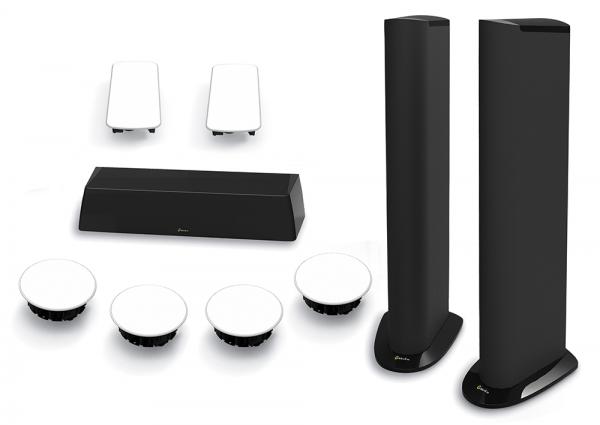
With the hindsight of four years of product development, GoldenEar reboots their very first speaker with updated drivers, crossover, and low-frequency DSP—to quite stellar results.
Specs
Triton Two+: 5 x 9 in glass fiber/Nomex composite cone woofer (2), 7 x 10 in MDF passive radiator (2), 4.5 in polypropylene cone midrange (2), 1 in folded planar magnetic tweeter; 5.25 (front)/7.5 (rear) x 48 x 15 in (WxHxD); 60 lb
SuperCenter XXL: 5.25 in polypropylene woofer (4), 6.75 x 8 in MDF passive radiator (2), 7 x 10 in MDF passive radiator, 1 in folded planar magnetic tweeter; 35 x 5.75 x 11 in (WxHxD); 31 lb
Invisa HTR 7000: 7 in polypropylene cone woofer, 1 in folded planar magnetic tweeter; 10 x 10 x 5 in (WxHxD); 4.5 lb
Invisa MPX: 4.5 in polypropylene cone woofer (2), 1 in folded planar magnetic tweeter; 7.25 x 13.9 x 3.75 in (WxHxD); 6 lb
Price: $7,750 (Triton Two+, $1,750 ea; SuperCenter XXL, $1,250; Invisa HTR 7000, $500 ea; Invisa MPX, $500 ea)
Unfortunately, the first GoldenEar Technology Triton Two loudspeaker I ever saw didn’t work. It wasn’t the result of shoddy workmanship, chintzy materials, or some brutal, shipping-induced internal hemorrhage of crossovers and cables. Truth be told, the speaker wasn’t technically a Triton Two because, at the time (in early January during CES 2010), GoldenEar Technology didn’t officially exist. The tall, dark tower standing silently in front of me was a cosmetic mock-up of what would become the Triton Two— GoldenEar’s first speaker. In other words, this mute monolith, wrapped in black fabric, was merely a hollow shell of its future towerful self.
I won’t spend much time retelling GoldenEar’s back story. If you’re interested in learning the impressive pedigree, see my review of the Triton One (Sound & Vision, June 2014 and soundandvision.com). The SparkNotes version goes like this, beginning in 1972: Sandy Gross co-founded Polk Audio and then Definitive Technology, the latter in partnership with quiet Canadian engineer extraordinaire Don Givogue. Gross and Givogue emerged from semi-retirement in 2010 (word is that Givogue was “slightly” reluctant and had to be dragged off his fishing boat) to start GoldenEar. This time around, Gross told me then, he wanted to design loudspeakers that sounded like the $10,000-plus pair of electrostatics he had in his listening room at home— but speakers that would be easier to live with and, most important, cost a lot less.
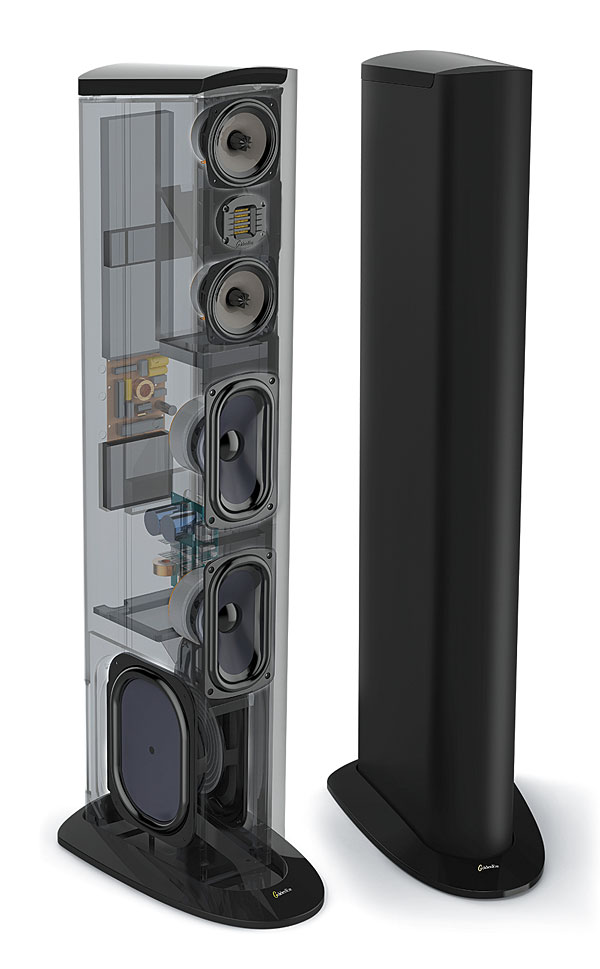
The Optimist’s Primes
After five years, the prime-numbered Triton speaker range includes, in order of creation, the Two, Three, Seven, Five, and ultimately, even though by definition not a prime number though integral to defining a prime number, the One. The Triton One is a truly amazing-sounding loudspeaker. But the fact that a pair of Ones will set you back only $5,000 is stunning. So many glowing reviews of the speaker have been published that I’ve heard the Oxford English Dictionary is planning to define “Triton One” as “so astoundingly awesome, you should bring along an extra pair of underwear.” (Or something like that.) There may also be a Triton One emoji coming soon.
Gross and Givogue don’t sit around all day building prototype speakers in their parents’ garages. GoldenEar has an engineering facility in Arnprior, Ontario, Canada. There, Bob Johnston and a team of engineers have enviable access to the company’s own full-size anechoic chamber, which Gross says is a “duplicate of the world-famous chamber at the NRC [National Research Council of Canada].” GoldenEar’s chamber is so serious that it’s “fully suspended from its environment, so that the delicate measurements taken within it are not interfered with by outside disturbances and vibrations such as beer bottles being opened or hockey pucks hitting the outside.” Actually, the beer and hockey references were added by me, not Gross. The point is that the chamber allows GoldenEar to measure subtleties and refine a speaker’s performance in a manner that’s potentially more revealing than other methods would be.
Although the anechoic chamber isn’t new, Gross says that since initially designing the Triton Two and Three speakers, GoldenEar acquired new development software, “including a unique program for cones and surrounds.” (He means the surrounds that encircle the outer edges of cone drivers—not surround speakers.) In other words, GoldenEar’s golden ears learned quite a bit along the Via Triton that culminated in the One.
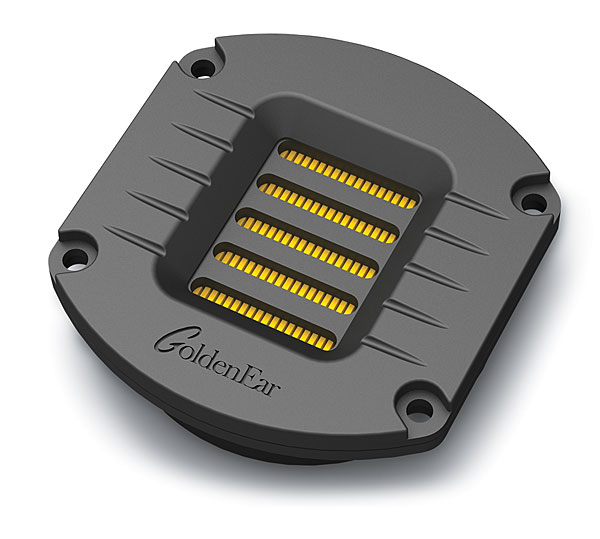
That left the original and early Triton Two feeling severely outdated. Gross wanted to produce a reality TV show, called Rehab My Speaker (the working title was Crossover This!), but he couldn’t get HGTV to run it. Instead, after binge-watching several seasons of The Six Million Dollar Man from the 1970s, Gross decided that the GoldenEar team should do their own upgrading of the Triton Two. Wisely realizing that no one would buy a Triton Two+ for six million dollars (GoldenEar speakers may be good, but they ain’t that good), the engineers didn’t add sophisticated robotic legs or computerized telescopic eyes—but the changes they did make were certainly noticeable.
Old Highs with New Lows
From the outside, the Triton Two+ looks virtually identical to the original Triton Two (the non-plus—but definitely not nonplussed—version). It has the same black cloth fabric over a columnar grille in the front, with a gloss black plinth and matching cap. The only difference is that the amplifier power-status LED is now a relatively bright blue, rather than the more subtle green. It’s bright enough that, in a very dark room, you might notice a radioactive-looking blue glow spilling along the floor behind the speaker. If it bugs you or breaks your mood, you can always put a piece of black electrical tape over it.
Behind the grille, the Two+ inherits the same High Velocity Folded Ribbon (HVFR) tweeter found in the Two and all the other Triton speakers. As we’ve frequently pointed out, this is technically a magnetic planar tweeter design that utilizes a flat diaphragm that has been pleated, like the sides of a squeeze-box (or accordion, for highfalutin people), and it creates sound by rapidly squeezing and stretching the pleats to compress and rarefy air. This proprietary tweeter plays a huge role in giving all the GoldenEar speakers their characteristic sound.
Brand new, however, are the two 4.5-inch midrange drivers mounted above and below the HVFR tweeter in a D’Appolito arrangement. They’re a huge beneficiary of Triton One hand-me-down technology, as they were re-engineered with a new cone, surround, spider, and voice coil. GoldenEar also developed a completely new balanced crossover incorporating polypropylene capacitors, one that is very similar to the crossover in the Triton One. The DSP-based low-frequency control unit for the amplified bass section has been reprogrammed, too. Gross was emphatic about getting the crossover design right. In fact, just like the cardinals at the Vatican when electing a new Pope, the engineers were locked in a room and required to try out all sorts of “subtle variations of crossover and DSP tuning in order to get the voicing exactly right.”
As as a result of the upgrades, Gross says the Triton Two+ benefits from “a significantly smoother, higher-resolution, more open, more revealing, and more highly detailed sound. In addition, there is dramatically more expansive imaging and tighter, faster, and better-integrated bass.”
The Big and Tall Man’s Center
We wanted to take the opportunity presented by the arrival of the Triton Two+ to listen to a few other GoldenEar models we’ve not yet heard, so we set up a Dolby Atmos 5.0.4 system that also included the new SuperCenter XXL center-channel speaker along with a pair of Invisa MPX in-walls for surrounds plus two pair of Invisa HTR 7000 in-ceiling speakers for the front and rear height channels. The middle zero in the Atmos configuration numbering isn’t a typo. Not only did GoldenEar not send a dedicated subwoofer, but—as per Gross’s usual recommendation—I also set the front speaker parameter to Large and ran only speaker wires to the Triton Two+ towers. In other words, neither the subwoofer output of the AVR nor LFE input on the Two+ was used. All deep bass was provided by the Tritons with their powered bass sections and built-in crossovers.
The appropriately named SuperCenter XXL is a monster, measuring 35 inches wide x 5.75 inches high x 11 inches deep. Inside the familiar black-fabric-sock grille cloth is a two-and-a-half-way design utilizing a three-chambered cabinet. The central chamber holds one HVFR tweeter plus two 5.25-inch woofers that are coupled to a 7 x 10-inch top-firing passive radiator. Two smaller chambers sandwich the central section, and each contains its own 5.25-inch bass driver (crossed over at a lower frequency than the 5.25-inch drivers used in the middle) coupled to a dedicated 6.75 x 8-inch passive radiator, which is also top-firing.
The architectural speakers from GoldenEar aren’t new. The round Invisa HTR 7000 is the company’s flagship in-ceiling model, using a 7-inch bass driver (the same one that’s in GoldenEar’s Aon 3 monitor speaker) and a smaller version of the HVFR tweeter. The driver assembly is angled so the dispersion pattern can be aimed in the direction of the listener, which makes the HTR 7000 especially applicable for systems using in-ceiling speakers for the front LCR channels. The rectangular Invisa MPX is what GoldenEar calls a “MultiPolar” architectural speaker because it uses a design that attempts to mind-meld a direct-radiating speaker with a bipolar speaker. In addition to the forward-firing HVFR tweeter (the smaller one), there’s a pair of 4.5-inch bass drivers—one above and one below the tweeter—angled out sideways of the tweeter, in as much of an approximation of opposite directions as can be expected from a flush in-wall speaker.
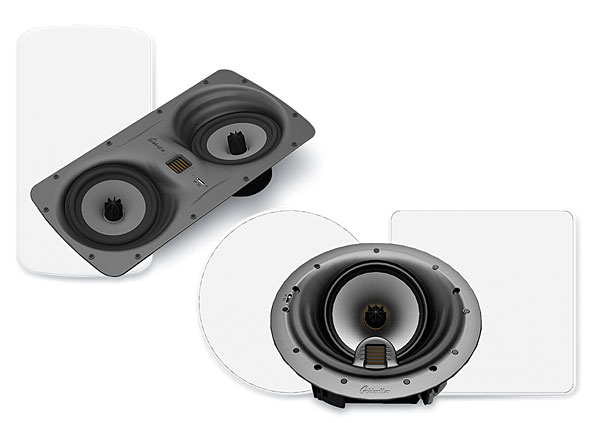
Virtually Reality
Four years is a long time between evaluations—too long to establish a solid frame of reference between the old Triton Two and the new Triton Two+ short of having both in the same room. But I did revisit much of the same demo material I used to review the then brand-new Triton Two in 2011. I’ve heard these music selections countless times on other speakers, but after I listened to them on the Triton Two+ towers, my initial reaction was: “Holy crap!” The soundstage on Roger Waters’ “The Ballad of Bill Hubbard” was as broad as, if not broader than, what I’ve heard with any other speaker pair. What struck me was a slightly forward presentation of Jeff Beck’s guitar in this track. I really noticed this on two pieces I listened to that feature a solo vocal with an acoustic guitar: Lyle Lovett’s “Promises” and Mary Chapin Carpenter’s “Dead Man Walking (A Dream Like This),” both from the tie-in CD to the film Dead Man Walking. In each case, it wasn’t that the vocal was inappropriately shifted forward. Rather, it seemed a tad more defined and distinct in the midst of the music without being distractingly (and annoyingly) in your face. The vocal was fully present without being overly dominant. The new Triton Two+ definitely nudges closer to what I recall as the sound of the Triton One I reviewed last year.
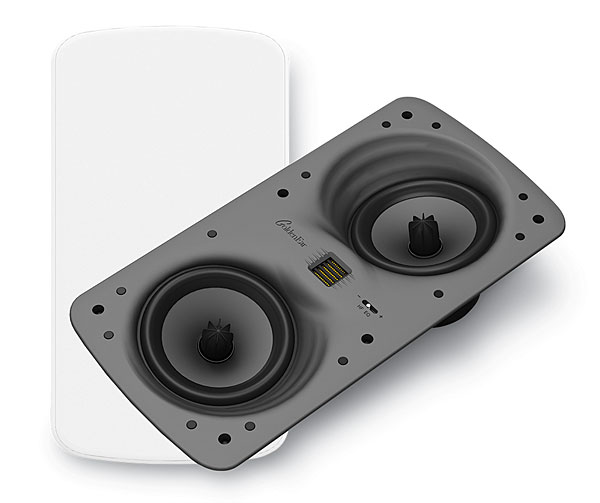
The care in executing the new DSP and the updated bass tuning were just as evident. Listening to “Tribute” from Ross William Perry’s It’ll All Make Sense demonstrated the claimed “tighter, faster, and better-integrated bass.” The output of the bass and midrange drivers are so closely woven together that it’s hard to believe it’s all coming from a variety of separate drivers and passive radiators. The three-dimensional playback of Dirk Sengotta’s “Drum Solo” from the Henrik Frieschlader Band’s Live disc was so arresting that it bordered on disorienting, with clear placement of each piece in the drum kit and every tap on a cymbal. If you could make a hologram out of sound, this would be it. For music listening, the Triton Two+ proved itself a truly captivating, sublime, and thoroughly engaging speaker.
Zero to Ten
With the Triton Two+ speakers anchoring the Dolby Atmos 5.0.4 configuration, it was no surprise that the bass output of the full theater system was sensational. As you’d expect, Terminator Genisys isn’t a quiet movie. With the GoldenEar system, each time a time machine was activated (spoiler alert: there’s a time machine in this movie), it was time for a low-frequency thrill ride. Of course, never having been near an actual time machine, I can’t say for sure how detailed and accurate the GoldenEars were. But I’m pretty sure that if there really were a time machine—which there isn’t because if there were, I’d have gone back and deleted this sentence—it would sound like what I heard with this system. In one scene, a bunker full of explosives undergoes some serious renovation, and the resulting shock wave was so impressively stable and full that I’m not sure there’s another powered tower speaker (perhaps short of a Triton One) that could match it.
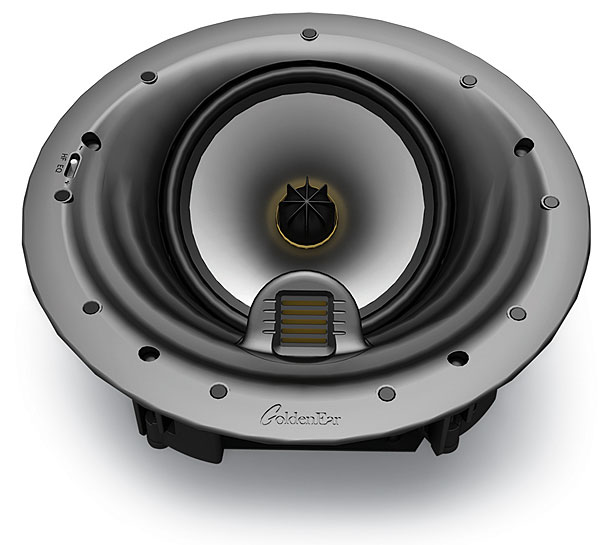
Mad Max: Fury Road isn’t a quiet movie, either. In this depiction of a nightmarish automotive future, the omnipresent rumble of particulate-spewing, flame-belching engines is an integral aspect of the story. A lesser system would no doubt leave you feeling cheated because your brain would be searching for what your ears weren’t hearing. But the Titan Two+ towers didn’t just rumble at lower and lower frequencies—the bass section was as detailed and nuanced as it was visceral and impactful.
Hearing Voices
If the rugged, intense bass were all these movies had going for them, well, then they’d still be popular. Fortunately for us, the Dolby Atmos soundtracks of both movies are spectacular 3D acoustic playgrounds that are remarkable examples of how good the new technology can be. I’m sure that the opening of Mad Max: Fury Road will soon become a de rigueur Atmos demo clip because the haunting voices from Max’s past come and go from all directions throughout the room. This scene was a great test of the close match between the SuperCenter XXL and the Triton Two+ towers—and especially of the beautifully smooth soundspace created by the Invisa HTR 7000s and Invisa MPXs.
Terminator Genisys has plenty of its own remarkable Atmos moments. In the opening scene, a young boy hides in a drainage tunnel because he’s afraid that something is coming his way; on the GoldenEar system, the sounds of a dog barking and the footsteps that echo off the curved enclosure were beautifully rendered. Here all the models sounded like one coherent unit instead of separate speakers that happened to have been thrown together.
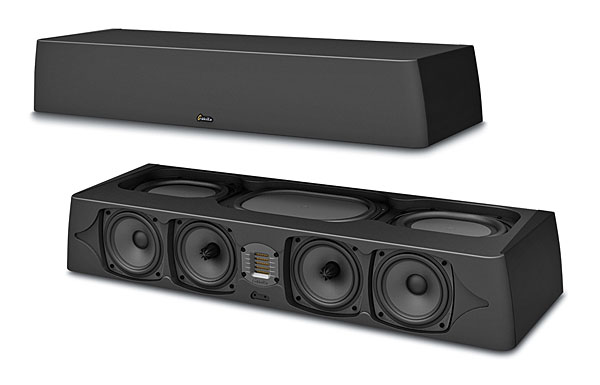
Speaking of performing as one, I was thrilled to hear the way the SuperCenter XXL was able to match the outstanding performance of the Triton Two+ pair. There’s a scene in Terminator Genisys, for example, where Sarah and Kyle are undressing on opposite sides of a row of gym lockers. As the camera pans back and forth, their voices move across the front of the room accordingly. To say that it didn’t even seem as if the SuperCenter XXL was present in the system is a tremendous compliment. The speaker never drew attention to itself, either by overemphasizing or underperforming.
Conclusion
GoldenEar Technology has quoted many reviewers (including yours truly) commenting that GoldenEar speakers sound as good as or better than speakers costing three times (or whatever) as much—a comment that justifiably annoys some people, who ask, “Really? Which ones?” That’s a difficult question to answer because there are so many factors that go into the value of a speaker, more than just sound and price, including cosmetic design, cabinet finish, size, placement requirements, application, power requirements, subwoofer or no subwoofer, etc. That’s not a cop-out. It’s simply a fact. I think the problem is that (in my case, anyway) I’ve been lazy and have taken the easy way of trying to convey my feelings about the value of GoldenEar speakers. What I should have said then—and what I emphatically say now about the Triton Two+ speakers—is that the sound quality is so good that GoldenEar’s speakers would still be highly recommended even if they cost three times as much. The fact that they don’t is one more reason why they are so damn impressive.




Connect With All Star